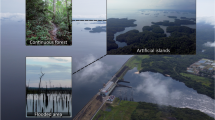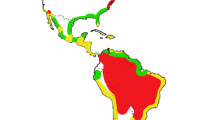Abstract
Avian blood parasites have been shown to have significant health effects on avifauna worldwide. Sri Lanka, a tropical island rich with resident and migratory birds, has not been properly evaluated for avian blood parasites or their vectors. We investigated the presence of avian haemoparasites in Sri Lankan birds and the potential mosquito vectors of those pathogens. Blood samples were collected from local/migratory birds captured by standard mist nets from Anawilundawa bird sanctuary, Hanthana mountain range, and the University of Peradeniya park. Mosquitoes were collected from Halgolla forest reserve and the forest patches in Kurunegala and Gampola areas in addition to the above mist-netting localities. Part of the mitochondrial cytochrome b (cytb) gene was amplified and sequenced to detect the presence of haemoparasites from avian blood samples (86) and mosquito samples (480). Blood parasites of the two genera, i.e., Haemoproteus (4 species; Haemoproteus sp. 1-4) and Plasmodium (5 species; Plasmodium sp. 1-5) were identified from seven bird species (four resident and three migratory). Among these, three bird species (Red-vented bulbul (3/16), Asian Brown flycatcher (1/1), and India pitta (1/1)) were positive for Plasmodium spp., while four (Yellow-browed bulbul (1/4), oriental white-eye (1/4), brown-headed Barbet (1/4), and Indian blue robin (1/1)) were positive for Haemoproteus spp. Two mosquito species were also positive for Plasmodium (3) and Haemoproteus (1) species. Phylogenetic analysis and haplotype networks created using positive sequences of haemoparasites showed that a Plasmodium clade was shared by Cx nigropunctatus mosquitoes and the migratory bird, Indian pitta. The majority (85%) of the Plasmodium and Haemoproteus sequences of this study were not linked to the well-characterized species suggesting the distinct nature of the lineages. Associations between mosquito species and blood parasites of birds suggest the possible vector status of these mosquitoes.



Similar content being viewed by others
Data availability
All relevant data will be freely available to any researcher to use them for non-commercial purposes.
References
Alley MR, Fairley RA, Martin DG, Howe L, Atkinson T (2008) An outbreak of avian malaria in captive yellowheads/mohua (Mohoua ochrocephala). N Z Vet J 56:247–251
Amerasinghe FP (1995) Illustrated keys to the genera of mosquitoes (Diptera: Culicidae) in Sri Lanka. J Nat Sci Council 23:183–211
Atkinson CT, Samuel MD (2010) Avian malaria Plasmodium relictum in native Hawaiian forest birds: epizootiology and demographic impacts on ‘apapane Himatione sanguinea. J Avian Biol 41:357–366
Barraud PJ (1934) The Fauna of British India, Including Ceylon and Burma. Diptera. Family Culicidae. Tribes Megarhinini and Culicini. Vol. V., Taylor and Francis, London
Bennett G, Peirce M, Ashford R (1993) Avian haematozoa: mortality and pathogenicity. J Nat Hist 27:993–1001
Chathuranga WGD, Karunaratne SHPP, Fernando BR, De Silva WAPP (2018) Diversity, distribution, abundance, and feeding pattern of tropical Ornithophilic mosquitoes. J Vector Ecol 43:158–167
Chen T, Aure WE, Cruz EI, Malbas FF Jr, Teng H, Lu L, Kim KS, Tsuda Y, Shu P (2015) Avian Plasmodium infection in field-collected mosquitoes during 2012–2013 in Tarlac, Philippines. J Vector Ecol 40:386–392
Clark NJ (2018) Phylogenetic uniqueness, not latitude, explains the diversity of avian blood parasite communities worldwide. Glob Ecol Biogeogr 27:744–755
Clark NJ, Clegg SM, Lima MR (2014) A review of global diversity in avian haemosporidians (Plasmodium and Haemoproteus: Haemosporida): new insights from molecular data. International Journal for Parasitology 44:329–338
Clark NJ, Clegg SM, Klaassen M (2016) Migration strategy and pathogen risk: non-breeding distribution drives malaria prevalence in migratory waders. Oikos 125:1358–1368
Clark NJ, Drovetski SV, Voelker G (2020) Robust geographical determinants of infection prevalence and a contrasting latitudinal diversity gradient for haemosporidian parasites in Western Palearctic birds. Mol Ecol 29:3131–3143
Dadam D, Robinson RA, Clements A, Peach WJ, Bennett M, Rowcliffe JM, Cunningham AA (2019) Avian malaria-mediated population decline of a widespread iconic bird species. R Soc Open Sci 6:182197
Dahlin K, Feng Z (2019) Modeling the population impacts of avian malaria on Hawaiian honeycreepers: bifurcation analysis and implications for conservation. Math Biosci 318:108268
Dimitrov D, Palinauskas V, Iezhova TA, Bernotienė R, Ilgūnas M, Bukauskaitė D, Zehtindjiev P, Ilieva M, Shapoval AP, Bolshakov CV, Markovets MY, Bensch S, Valkiūnas G (2015) Plasmodium spp.: an experimental study on vertebrate host susceptibility to avian malaria. Exp Parasitol 148:1–16
Dunn JC, Cole EF, Quinn JL (2011) Personality and parasites: sex-dependent associations between avian malaria infection and multiple behavioral traits. Behav Ecol Sociobiol 65:1459–1471
Ejiri H, Sato Y, Sasaki E, Sumiyama D, Tsuda Y, Sawabe K, Matsui S, Horie S, Akatani K, Takagi M, Omori S, Murata K, Yukawa M (2008) Detection of avian Plasmodium spp. DNA sequences from mosquitoes captured in Minami Daito Island of Japan. J Vet Med Sci 70:1205–1210
Ejiri H, Sato Y, Kim K, Tamashiro M, Tsuda Y, Toma T, Miyagi I, Murata K, Yukawa M (2011) First record of avian Plasmodium DNA from mosquitoes collected in the Yaeyama Archipelago, southwestern border of Japan. J Vet Med Sci 73:1521–1525
Farajollahi A, Fonseca DM, Kramer LD, Kilpatrick AM (2011) “Bird biting” mosquitoes and human disease: a review of the role of Culex pipiens complex mosquitoes in epidemiology. Infect Genet Evol 11:1577–1585
Ferraguti M, Heesterbeek H, Martínez-de la Puente J, Jiménez-Clavero MÁ, Vázquez A, Ruiz S, Llorente F, Roiz D, Vernooij H, Soriguer R, Figuerola J (2020) The role of different Culex mosquito species in the transmission of West Nile virus and avian malaria parasites in Mediterranean areas. Transbound Emerg Dis:1–11
French N, Yu S, Biggs P, Holland B, Fearnhead P, Binney B, Fox A, Grove-White D, Leigh JW, Miller W, Muellner P (2014) Evolution of Campylobacter species in New Zealand. Campylobacter ecology and evolution, Caister Academic Press, Swansea University, Swansea, UK
Gutiérrez-López R, Martínez-de la Puente J, Gangoso L, Soriguer R, Figuerola J (2020) Plasmodium transmission differs between mosquito species and parasite lineages. Parasitology 147:441–447
Huelsenbeck JP, Ronquist F, Nielsen R, Bollback JP (2001) Bayesian inference of phylogeny and its impact on evolutionary biology. Science 294:2310–2314
Ishtiaq F, Gering E, Rappole JH, Rahmani AR, Jhala YV, Dove CJ, Milensky C, Olson SL, Peirce MA, Fleischer RC (2007) Prevalence and diversity of avian haematozoan parasites in Asia: a regional survey. J Wildl Dis 43:382–398
Ishtiaq F, Guillaumot L, Clegg SM, Phillimore AB, Black RA, Owens IPF, Mundy NI, Sheldon BC (2008) Avian haematozoan parasites and their associations with mosquitoes across the Southwest Pacific Islands. Mol Ecol 17:4545–4555
Kimura M, Darbro JM, Harrington LC (2010) Avian malaria parasites share congeneric mosquito vectors. J Parasitol 96:144–151
Kumar S, Stecher G, Tamura K (2016) MEGA7: Molecular Evolutionary Genetics Analysis version 7.0 for bigger datasets. Mol Biol Evol 33:1870–1874
Lanfear R, Calcott B, Ho SYW, Guindon S (2012) PartitionFinder: combined selection of partitioning schemes and substitution models for phylogenetic analyses. Mol Biol Evol 29:1695–1701
Lanfear R, Frandsen PB, Wright AM, Senfeld T, Calcott B (2017) PartitionFinder 2: new methods for selecting partitioned models of evolution for molecular and morphological phylogenetic analyses. Mol Biol Evol 34:772–773
LaPointe DA, Goff ML, Atkinson CT (2005) Comparative susceptibility of introduced forest-dwelling mosquitoes in Hawai’i to avian malaria, Plasmodium relictum. J Parasitol 91:843–849
Livak KJ (1984) Organization and mapping of a sequence on the Drosophila melanogaster X and Y chromosomes that is transcribed during spermatogenesis. J Genet 107:611–634
Martínez-de la Puente J, Soriguer R, Senar JC, Figuerola J, Bueno-Mari R, Montalvo T (2020) Mosquitoes in an urban zoo: identification of blood meals, flight distances of engorged females, and avian malaria infections. Front Vet Sci 7:460
Palinauskas V, Valkiunas GN, Bolshakov CV, Bensch S (2008) Plasmodium relictum (lineage P-SGS1): effects on experimentally infected passerine birds. Exp Parasitol 120:372–380
Rambaut A, Suchard MA, Xie D, Drummond AJ (2014) Tracer v1.6. Available from http://tree.bio.ed.ac.uk/software/tracer.
Ronquist F, Teslenko M, van der Mark P, Ayres DL, Darling A, Höhna S, Larget B, Liu L, Suchard MA, Huelsenbeck JP (2012) MrBayes 3.2: efficient Bayesian phylogenetic inference and model choice across a large model space. Syst Biol 61:539–542
Santiago-Alarcon D, Palinauskas V, Schaefer HM (2012) Diptera vectors of avian Haemosporidian parasites: untangling parasite life cycles and their taxonomy. Biol Rev 87:928–964
Schoener ER, Banda M, Howe L, Castro IC, Alley MR (2014) Avian malaria in New Zealand. N Z Vet J 62:189–198
Soares L, Young EI, Ricklefs RE (2020) Haemosporidian parasites of resident and wintering migratory birds in The Bahamas. Parasitol Res 119:1563–1572
Valkiūnas G (2005) Avian malaria parasites and other haemosporidian. CRC Press, Boca Raton, FL, USA
Valkiūnas G, Lezhova TA (2018) Keys to the avian malaria parasites. Malaria J 17:212
Valkiūnas G, Santiago-Alarcon D, Levin II, Iezhova TA, Parker PG (2010) A new Haemoproteus species (Haemosporida: Haemoproteidae) from the endemic Galapagos dove Zenaida galapagoensis, with remarks on the parasite distribution, vectors, and molecular diagnostics. J Parasitol 96:783–792
Valkiunas G, Ilgūnas M, Bukauskaitė D, Fragner K, Weissenböck H, Atkinson CT, Iezhova TA (2018) Characterization of Plasmodium relictum, a cosmopolitan agent of avian malaria. Malar J 17(1):184
Van Hemert C, Meixell BW, Smith MM, Handel CM (2019) Prevalence and diversity of avian blood parasites in a resident northern passerine. Parasit Vectors 12:292
Waldenström J, Bensch S, Hasselquist D, Östman O (2004) A new nested polymerase chain reaction method very efficient in detecting Plasmodium and Haemoproteus infections from avian blood. J Parasitol 90:191–194
Yorinks N, Atkinson CT (2000) Effects of malaria on activity budgets of experimentally infected juvenile Apapane (Himatione sanguinea). Auk 117:731–738
Žiegytė R, Valkiūnas G (2015) Recent advances in vector studies of avian haemosporidian parasites. Ekologija 60:73–83
Zittra C, Kocziha Z, Pinnyei S, Harl J, Kieser K, Laciny A, Eigner B, Silbermayr K, Duscher GG, Fok É, Fuehrer HP (2015) Screening blood-fed mosquitoes for the diagnosis of filarioid helminths and avian malaria. Parasit Vectors 8:16
Acknowledgments
The authors are thankful to Mr. S.L.N. Samarasinghe, Department of Zoology, University of Peradeniya, Sri Lanka for his assistance in field sampling. The Department of Wildlife Conservation and the Forest Department of Sri Lanka are highly acknowledged for the given permission to collect samples as well as the provided support in the field.
Funding
This work is funded by the National Research Council Grant No 2016-059, Sri Lanka and the University of Peradeniya (Research Grant Number 2016-51/S), Sri Lanka.
Author information
Authors and Affiliations
Contributions
W.A.P.P. de Silva contributed to the conception of the idea, funding acquisition, project design, data collection, analysis and paper writing. W.G.D. Chathuranga contributed to data collection, analysis and paper writing. B.R. Fernando contributed to project designing, data collection, analysis and paper writing. T.C. Weeraratne contributed to project designing, data analysis and paper writing. S.H.P.P. Karunaratne contributed to project designing and paper writing.
Corresponding author
Ethics declarations
Conflict of interest
The authors declare that they have no conflict of interest.
Ethical approval
All procedures performed involving animals were in accordance with the ethical standards and the approval was obtained from the ethics committee of Postgraduate Institute of Science University of Peradeniya (approval number: ECC_PGIS_2017_05), Sri Lanka.
Additional information
Section Editor: Larissa Howe
Publisher’s note
Springer Nature remains neutral with regard to jurisdictional claims in published maps and institutional affiliations.
Rights and permissions
About this article
Cite this article
Chathuranga, W.G.D., Fernando, B.R., Weereratne, T.C. et al. Blood parasites of bird communities in Sri Lanka and their mosquito vectors. Parasitol Res 120, 693–703 (2021). https://doi.org/10.1007/s00436-021-07049-3
Received:
Accepted:
Published:
Issue Date:
DOI: https://doi.org/10.1007/s00436-021-07049-3




